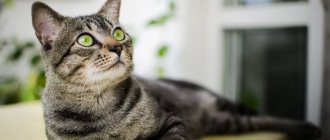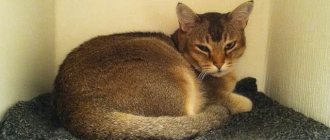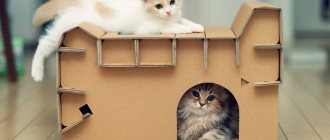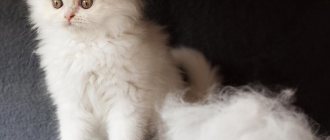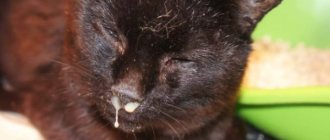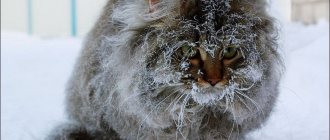Origin story
The home of European Shorthairs is the entire continent.
For many years, these animals lived in European settlements next to humans. They helped people catch small rodents that tried to spoil the harvest. The genes turned out to be strong and were perfectly passed on through generations of cats; the European Shorthair developed a certain appearance and temperament. English breeders took up the development of the breed. In the 19th century, they first demonstrated the breed at a cat show, but did not receive any prizes or high places, since at that time the species was not officially recognized. They were classified as a British breed, and at championships and exhibitions British standards were used to select winners.
The issue of separating these species was decided in 1982 when FIFe, one of the largest cat associations, introduced different standards for British and European cats. Now European Shorthairs include animals that live in a specific territory and meet fixed standards.
European Shorthair cat breed
Diet
It is recommended to feed European cats with industrial dry and wet food. The higher the grade of feed, the better its quality. It's better not to buy economy class.
Be sure to read:
Tailless Manx cats: origin, description and care
Europeans can buy special grass. It helps get rid of hairballs that a cat swallows while licking itself.
Important! You cannot feed your animal meat and fish without heat treatment.
Interesting Facts
- the oldest cat breed in the world is at the same time the youngest in the FIFe classification, because the European Shorthair received official recognition only in 1982;
- there are many names for these cats depending on the geography of origin and breeding: European shorthair (smooth-haired), European longhair, Eastern European cat, Swedish, Celtic;
- a cat of this species is more of a companion than a relative, due to its independent character and free disposition;
- on the scale of temperament, they occupy the golden mean: affectionate, but without intrusiveness, they have leadership inclinations, but not aggressive.
Forest cat at home
If you want to have this freedom-loving and independent animal, it is better to turn to professional breeders. Because animals, accustomed from birth to humans, dull their predatory instincts and learn to accept food and care from human hands. In addition, serious nurseries always take care of vaccination and deworming of their pets.
Did you know? According to the works of the famous biologist Sabaneev, in the Middle Ages in Spain, the fur of the Pyrenean wild cat was used to trim the outfits of courtiers and for the production of premium parchment, the so-called “cat parchment”.
Please note that animals accustomed to natural conditions require a lot of space and freedom, so
a large private house is more suitable for them than a standard apartment.
Character and behavior
Forest cats living in nature are distinguished by a wary, often aggressive character and in natural conditions prefer not to come close to human habitation. By nature, these animals are loners. At the same time, one individual controls an area of about three square kilometers.
Therefore, you must be prepared for the fact that even at home your pet will not become an affectionate and gentle cat. He has a complex and independent character and can even hiss at his owner. But in general, he does not like conflicts, behaves balancedly, and does not show aggression without reason.
Important! The wild cat is very observant and conservative and likes everything to remain in its place. It is active at night, which can cause inconvenience to its household. He does not recognize strangers in the house and avoids them.
The forest cat is usually
quite silent, only making calling sounds during the mating season. However, if there is aggression towards him, he will actively hiss, howl and whistle.
Given the opportunity, the cat will happily spend time in the fresh air, climbing trees and exploring the local area.
Nutrition
The diet of a Norwegian forest cat should be as identical to its natural diet as possible. To understand what to feed it, you need to understand what these animals eat in nature. And under natural conditions, a cat mainly eats protein foods. Therefore, her diet must include:
- fish;
- lean meat;
- offal;
- eggs;
- dairy products.
Don't forget about vitamin complexes. In addition, you can provide your cat with a container of sprouted oats and sprouts of special cat grass.
Please note that a diet unusual for a wildcat can disrupt its phosphorus-calcium metabolism and lead to injuries and even fractures of the animal’s bones. And its impressive mass will further complicate the situation.
If you prefer dry food, then do not forget about constant access to fresh water for your pet.
If you want to be sure that your pets receive all the necessary nutrients, give them food: Hills, Purina, Gina, Gourmet, Royal Canin, Monge, FortiFlora, Probalance ", "Acana", "Felix", "Pro Plan" and "Kitekat".
Health
The lifespan of the Central European forest cat reaches 15 years in the forest and 30 years in captivity, which exceeds that of domestic animals.
Thanks to the centuries-old history of ancestors living in harsh natural conditions, the wild cat genetically has excellent immunity and good health. However, there are several diseases that are most common in this breed:
- glycogenosis - a rare hereditary disease associated with glucose metabolism, leads to the death of kittens within a few months after birth;
- polycystic kidney disease - numerous cysts in the kidneys lead to deterioration of their function, diagnosed by ultrasound;
- hypertrophic cardiomyopathy - hereditary heart disease;
- retinal dysplasia - the appearance of spots on the retina of the eyes leads to decreased vision.
Fortunately, all of these diseases are not that common. The main task of the owner is to provide the animal with high-quality and balanced nutrition, timely vaccinations, anthelmintics and all the necessary vitamins and minerals. And then your pet will delight you with its cheerfulness and vitality.
Cats, like people, need vitamins. Read about the criteria for choosing vitamins for cats.
Reproduction
Female wild cats become sexually mature at 9-10 months of life, and males only in the third year. When a cat is ready to mate, it produces odors that attract males. In nature, real fights take place between cats, and the winner gets the opportunity to conceive their offspring.
The Central European cat's gestation period is 63-68 days, and 1-7 kittens are usually born. The babies weigh no more than 250 grams, cannot see anything, do not stand well on their paws and are in complete need of care.
Kittens' eyes open on days 9-11 after birth, and feeding them with mother's milk lasts 3-4 months. By about five months, kittens become completely independent.
Appearance
Noble European felines are not as popular as other species. You rarely see them at an exhibition because of their strong resemblance to street cats. But real Europeans are slightly different from street animals in appearance, as well as in their developed hunting instinct.
Dimensions and weight
The European breed has pronounced sexual dimorphism: cats and female cats vary in size and weight. The cats are medium or large, elegantly built, weighing about 4 kg. Cats have a more powerful build; due to their developed muscles, their weight can reach 8 kg.
In both sexes, the body is flexible, with a straight back and a well-developed convex chest.
What does the European Shorthair look like?
Anatomical characteristics
In terms of body parameters, the European Shorthair cat breed does not differ from street cats in the classification:
- The skull (and with it the forehead and muzzle) is rounded and oblong. The nose is medium-sized, smooth, and forms a small dimple at the junction with the forehead. The chin stands out well and has strong strong-willed features.
- The eyes are round, looking with all their might. They can be any color, and sometimes different colors (heterochromia).
- The ears are located vertically at a short distance from each other. The ear always has a rounded tip, which is sometimes decorated with a tassel.
- The paws are round with elastic gray or pink pads. The limbs themselves are of medium length, strong, and proportionally developed.
- The tail is of medium length, thick at the base, and then tapers and ends in a rounded vertebra.
Anatomical features of the European Shorthair
The main difference between the species is its natural phenotype, that is, there are no admixtures of genes from other cat breeds.
Color and coat type
Pedigree cats have dense, thick, short hair. A small undercoat ensures smooth hair, elasticity and a noble shine.
Appearance of the European Shorthair
The FIFe standard has officially defined more than 50 types of colors in natural shades (from white to black). At the same time, breeders prefer to focus on one rare color and develop their signature representatives on its basis.
The most valuable species are considered to be tabby animals, namely white (silver), gray (marbled), red (golden) European shorthair cats. In addition to these colors, cats can be in the palette bicolor, tricolor, brindle, spotted, shaded (including chocolate, blue, red, cream shades).
European Shorthair colors
Features of character and behavior
The origin of a cat, especially a European Shorthair, determines the description of the breed in terms of character and behavior. So these cats love to walk along the street, are well oriented in space, and are friends with the owner.
Because of its wild ancestors, the European Shorthair loves to go for walks outside.
The European woman quickly adapts to her new home, and her habits begin to closely resemble the actions of her owner. At the same time, she does not depend much on the owner, she wants to play on her own, she wants to sleep. Therefore, if you often go on business trips or stay late at work, the cat will survive.
This breed is also distinguished by intelligence and intelligence. In addition to quick basic training, a cat can show excellent results in training. He does not make noise, often spends his days in silence, and according to his owners, he meows when he is hungry or the door to the toilet is closed.
The cat is loyal to all family members and will never show aggression unless it is a necessary measure due to fear or severe stress. The European breed loves to be active: toys, running around, catching its tail. She happily joins in play with people, so she comes into the house with children.
European Shorthair is a playful breed
They quickly find common interests with other pets similar in size, like cats or dogs. But rats, small birds, hamsters, guinea pigs are a source of danger for them, pests, so all efforts will be devoted to protecting household members from their presence on the territory.
European cats are friends with other cats in the family
Choice of kitten and price
Kittens are sold by both private breeders and nurseries. It’s better not to take a very small kitten, but to book one you like until it grows to at least three months.
The price of a kitten is about 10,000 rubles.
Kittens are sold by both private breeders and nurseries
In Russia, the demand for the European Shorthair breed is low, as people do not understand the characteristics of the breed. In Finland, on the contrary, this breed is very popular.
Be sure to read:
Cats that look like a leopard: cats with brindle and leopard coats
Care and maintenance
This breed does not require any special cat care skills. However, to comply with basic hygiene standards, some items are still needed:
- tray with filler that does not cause allergies;
- separate molds for food and water;
- various care accessories (combs, nail clippers, shampoo and others);
- scratching post, if necessary.
And, of course, the pet must have a place where it can hide from strangers or just take a nap. Usually it arises by itself, but you can buy a cat house where the animal will feel protected.
The European Shorthair loves to be alone and spend time alone.
As for grooming procedures, these are also the basic ones required for each breed:
- Eyes. To avoid inflammation or infection, use a sponge soaked in water. Wipe your eyes as needed as soon as you notice dirt.
- Ears. Also wipe the visible part of the ear with a sponge soaked in the solution. Smooth and large, they collect enough dust that the cat cannot always cope with it on his own.
- Wool. If necessary, clean with a damp cloth, and if heavily soiled, bathe with cat shampoo. During periods of shedding, in order to speed up the process, it is recommended to comb the fur with a natural bristle brush.
- Claws. With a convenient scratching post, a European can handle the grooming himself. If there is nowhere to install it, you need to trim it with a nail clipper once a month.
- Teeth. Regular cleaning is the key to health. To do this, you will need a soft brush, special toothpaste and 10 minutes several times a month. In addition, you need to take your cat to the veterinarian for an oral cavity check once a year.
Caring for the European Shorthair
The frequency of grooming procedures directly depends on the animal’s proper nutrition.
How to choose?
It is very difficult to carry out work on breeding purebred European cats in Russia. The main reason is the low probability of leaving the kitten in good hands. Calico cats are often treated as standard non-pedigreed animals. There are often cases of deception when owners try to pass off a non-purebred European as a purebred animal.
When purchasing, you need to be careful when choosing a Celtic cat. It must comply with all International Federation standards. Europeans do not lend themselves to hybridization, otherwise the animal will not meet all the requirements of the variety. If you want to have a purebred purebred European cat, then you need to familiarize yourself with all the nuances of appearance and character, and also be prepared for all the difficulties in keeping it.
There are no large nurseries in our country that would breed European smooth-haired cats. Therefore, to purchase an animal, it is better to contact private nurseries. The cost of this breed can vary from 2 to 15 thousand rubles. The price depends on the number of titles awarded to the kitten's parents and its class.
It is recommended to separate a kitten from its mother no earlier than three months after birth. At this age, it is easier for kittens to adapt to new living conditions, as well as to get used to their owners. The older the animals are, the harder it is for them to get used to something new. It is best to find a breeder in advance and get to know your pet for some time before taking it home. In this case, you can get detailed advice from animal care specialists.
Carefully consider your future pet before purchasing. He must not only meet all the qualities of the breed, but also have good health and a strong physique. The absence of diseases can be indicated by the cleanliness of the animal, this applies to the eyes, ears and nose.
You should also pay attention to the cleanliness of the anus. A healthy kitten should have a shiny coat without any flaws.
The claws must be well-groomed and not broken. Another sign of a healthy kitten is energy. A pet cannot be aggressive towards others.
Upon purchase, breeders undertake to provide the new owner with the necessary package of documents:
- passport;
- pedigree;
- information about vaccinations performed;
- contract of sale.
Catering
The greatest care for teeth is needed when eating natural products. In this case, cats are allowed to eat:
- meat and offal: beef, chicken, turkey, rabbit, veal three times a week, raw or boiled (from 30 grams for a kitten, 100 grams for an adult);
- sea fish: hake, trout, salmon, cod, salmon once a week;
- fermented milk products of medium fat content without flavorings or dyes: kefir, fermented baked milk, cream, sour cream, yogurt, cottage cheese can be given daily;
- boiled eggs 1-2 times a week;
- cereals, porridges: millet, oatmeal, rice, pearl barley, buckwheat several times a week with the addition of olive or vegetable oil;
- vegetables, stewed, boiled or raw: pumpkin, carrots, zucchini, green beans, cauliflower;
- Vitamin supplements and sprouted greens are given in the food in consultation with the veterinarian.
Healthy European Shorthair cat
What human food should kittens not eat:
- meat waste: tripe, bones, skin, lard;
- fatty foods: mayonnaise, avocado, pork and others;
- products with a large number of flavoring additives: sweets, baked goods, smoked products, sausages, sausages, spices (salt, sugar, sauces);
- a number of vegetables: potatoes, legumes, tomatoes, eggplants.
Increasingly, veterinarians recommend maintaining a balanced diet for your pet not with natural products, but with industrially produced food. Although Europeans are not inclined to overeat, and also do not have any special dietary instructions, ready-made food is much better thought out in terms of the amount of useful microelements. With them, the cat will not need additional feeding.
Ready-made feeds come in the following types:
- Holistics are the best in quality. In addition to fresh dehydrated meat, fish, vegetables or fruits, they use vitamin and mineral supplements.
- Super premium. They differ from the former in smaller amount of meat, but in the same quality and composition of nutrients.
- Premium and Economy. They cost much less, but the ingredients used are not the best meat parts. Often such foods cause an allergic reaction in a pet.
When choosing industrial food, be guided by the weight, age and health indicators indicated on the packaging, as well as reviews from experienced owners.
Health
Because of their roots, European Shorthair cats have almost no health problems, and genetic diseases do not bother them at all. To prevent infectious diseases, you need to undergo routine vaccinations against fleas, ticks, and helminths, and also take your cat to the veterinarian.
- Vaccinations: the first vaccination of major diseases is carried out at 3-4 months, the second – after another three weeks. Next, you need annual revaccination of adults, as well as a rabies vaccination once every 3 years.
- Treatment against parasites: shampoos, sprays, drops on the withers, collars. They are used at the first signs of infection, when the cat begins to scratch restlessly, especially in the ear area.
- Fight against internal parasites, once every six months for prevention or before significant events in the pet’s life (exhibition, vaccination, mating).
European shorthair cat
Exhibition specimens are subject to much more health requirements. Thus, deviations from the standards of the European Shorthair breed include:
- a wide muzzle as a sign of the British branch of selection;
- tail creases;
- white spots in the color (accepted only as the main color);
- saggy cheeks;
- weak chin;
- too long and soft wool.
Health of Eastern European cats
The Celts have good immunity, which they inherited from their ancestors. Cats of this breed are very hardy, they almost never get sick. European Shorthairs are very clean and are not afraid of water procedures.
Diseases and breed defects
The health of the European Celtic cat is strong and all this is due to the fact that only the best specimens were used during crossing. They do not suffer from hereditary diseases, and there are no developmental defects. Cats receive standard vaccinations.
Lifespan
Eastern European cats are characterized by good health and can live up to 15 years or more.
Features of mating of the European Shorthair cat
Choosing a partner for mating a European Shorthair
The first mating is recommended at the age of 1.5 years, by the third heat. At the same time, the cat must have all the necessary vaccinations so as not to doubt the health of the offspring. The peculiarity of breeding purebred cats is that they require two show cats. That is, if your pet is a champion, then your partner must also have the appropriate documents. Only in this case can you get beautiful, healthy, purebred kittens.
European women have good health, so pregnancy and further childbirth occur without complications.
Buy a Celtic cat
In Russia now there are no nurseries where Celtic cats are bred, and in Europe there are noticeably fewer people willing to work with EKSH. There are, however, several nurseries in Belarus (Minsk and Vitebsk). The decline in interest in the breed is explained by the discrepancy between costs and profits received.
Nobody wants to buy cats that resemble city basement dwellers (after all, few people understand the nuances of the phenotype). The rare domestic breeders who bred EKSH have long switched to more prestigious, exotic and well-selling breeds. Simply put, you will have to go abroad to find a real Celtic kitten.
What to pay attention to
Visually, you are unlikely to distinguish a purebred EKSH from a barn cat, so study the manufacturers’ documents and the reputation of the cattery itself. Remember that these days even club Celtic cats are increasingly moving away from the breed standard, and the condescension of experts is to blame for this. It is they who turn a blind eye to such deviations in the exterior as:
- non-standard arrangement of white spots;
- straight profile line;
- blurry drawing;
- bone poverty;
- changed coat texture.
Year after year, the diversity of EKSH breeds (recognized as one of the breed problems) increases, and the colors lose their expressiveness.
As a result, there is a high probability that instead of a celt, they will slip you a Vaska from the nearest gateway.
Celtic cat kitten price
Clubs do not share information about the selling price of their pets - they provide this information to the buyer. It is only known that the price for an EKSH pet-class kitten starts at 425 EUR.
Castration and sterilization: at what age is recommended
If the owner is not interested in cat offspring, the animal can be castrated/sterilized. It is recommended to do this at the age of 8-9 months, before the cat’s first heat. At the same time, if the owner missed this period, it is not recommended to use hormonal drugs to drown out the instincts. Such interference can negatively affect the cat's health.
At what age should a cat be neutered?
Advantages and disadvantages
In terms of anatomical characteristics, this is the most undemanding option: good health, moderate shedding, omnivorous.
For owners of a private home, this is the best option. The European is an excellent mousecatcher, faithfully defends its territory and loves to soak up the outdoor sun. This is a plus for a family home due to the playfulness and non-aggressive nature of the breed. You can safely leave your children with a cat without fear of a conflict of interest. This breed has many advantages for independent people. If a person works a lot outside the home or cannot give the cat enough attention, it will cope with its interests on its own.
The negative aspects are associated with the cat's activity at night, as well as territorial protection from rodents and small birds, so other pets may be in danger when living with it.
Reviews of the European Shorthair on Irecommend:
- “The cat is cool! A little harmful character, but a fun and interesting life is guaranteed. And there is little hassle with him. Little fur, almost no mischief and no screaming. Loves to sleep with his owners. And we love to sleep with him. He is soft, fluffy, lies calmly even all night. In winter it’s a super warmer! It’s pleasant for both soul and body.”
- “This is a dream cat. A friend to whom you come to tell all your worries, sometimes cry, sometimes squeeze. And she endures all this with the patience of a Goddess. And then he turns on the engine and starts it to calm and lull the owner. If you’re sick, she’s nearby, if you’re sad, then right there.”
- “My cat is amazingly positive and cheerful. She is always in a good mood, she rarely gets offended, she is always happy to see you. You look at her and your mood improves. I also noticed that she likes to change her place of rest - she sleeps in one place, then in another. Wayward. It happens that she herself requires solitude, so that she will not be touched. It’s the same with food, sometimes he refuses his favorite food and waits for another package to be opened, but he won’t touch it. The next day he eats it again with appetite.”
